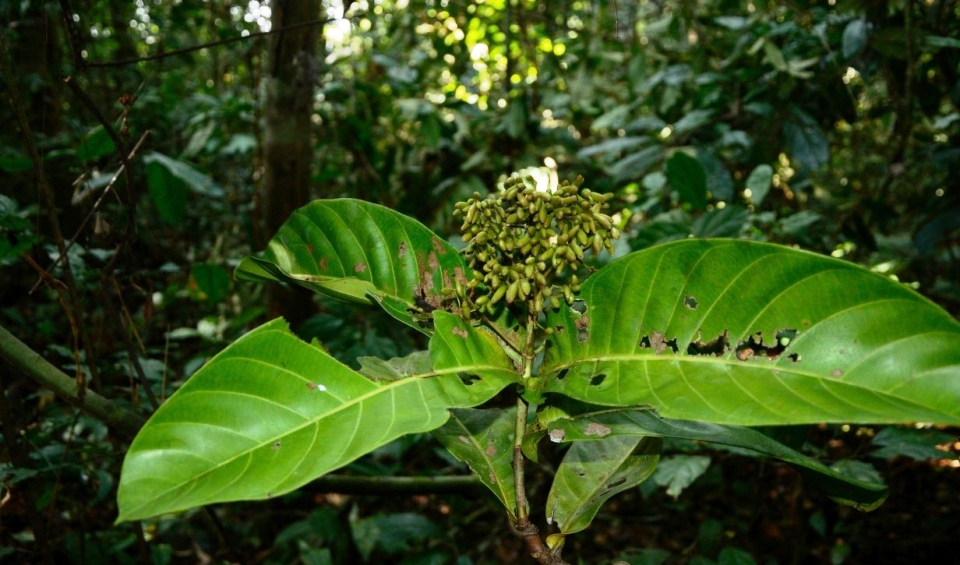Pausinystalia yohimbe

|
|
Corynanthe johimbe Common Names: Yohimbe, Yohimbe bark, Burantashi Scientific Classification Kingdom: Plantae Clade: Tracheophytes Clade: Angiosperms Clade: Eudicots Clade: Asterids Order: Gentianales Family: Rubiaceae Genus: Corynanthe Species: C. johimbe Synonyms: Pausinystalia johimbe (K.Schum.) Pierre, Pausinystalia zenkeri W.Brandt, Pseudocinchona johimbe (K.Schum.) A.Chev., Pausinystalia trillesii Beille Morphological Description Corynanthe johimbe is an evergreen tree, typically growing 15–30 meters tall,
with a straight bole rarely exceeding 50–60 cm in diameter. Its key
characteristics include: · Bark: Grey to reddish-brown, with longitudinal fissures,
bitter-tasting; inner bark pinkish, fibrous, rich in alkaloids (Burkill, 1985). · Leaves: Arranged in whorls of three, oval-shaped (11–47 cm × 5–17
cm), glossy green, with short petioles (0.5–1 cm); veins prominent (Fern,
2024). · Flowers: Small, yellowish-white, in axillary or terminal panicles;
5-petaled, fragrant, blooming seasonally (Prance & Jongkind, 2015). · Fruit: Capsules, small (1–2 cm), dark brown, containing winged
seeds; dispersed by wind (Kew Science, n.d.). Distribution and Habitat Corynanthe johimbe is native to western and central Africa, thriving in
specific ecological niches: · Geographic Range: Found in Nigeria, Cameroon, Gabon,
Equatorial Guinea, Congo-Brazzaville, and DR Congo; prevalent in Nigeria’s
Atlantic evergreen forests (Kew Science, n.d.). · Habitat: Grows in lowland rainforests, closed-canopy forests, and
coastal forests; prefers well-drained, loamy soils (pH 5.5–6.5) with annual
rainfall of 1,500–2,500 mm; occurs at elevations up to 1,000 m (Fern, 2024). · Ecological Role: Supports pollinators like bees;
contributes to forest biodiversity; over-exploitation threatens local
populations (Burkill, 1985). Ethnopharmacology Corynanthe johimbe is a cornerstone of West African traditional medicine, with
pharmacological studies validating several applications (Iwu, 2014): · Aphrodisiac: In Nigeria, bark decoctions are used to enhance libido.
Yohimbine, an α2-adrenergic receptor antagonist, increases blood flow and nerve
impulses to sexual organs, supporting its use for erectile dysfunction (ED) in
animal studies, though human efficacy is inconsistent (Tam et al., 2001). · Stimulant: In Cameroon, bark is chewed to combat fatigue. Yohimbine’s
CNS stimulation enhances alertness, with mild monoamine oxidase inhibitor
(MAOI) properties (De Smet, 1997). · Antimalarial: In Nigeria, leaf infusions treat malaria. While direct
studies on C. johimbe are
limited, corynanthe alkaloids show antiplasmodial activity in related species,
suggesting potential (Rosales et al., 2020). · Analgesic: In Ghana, bark extracts alleviate pain. Yohimbine’s opioid
receptor binding provides analgesic effects, though less potent than morphine
(Takayama, 2004). · Antidepressant Potential: In Nigeria, bark is used for mood
enhancement. Yohimbine’s sympathomimetic activity may boost mood, but clinical
evidence is lacking (Cimolai & Cimolai, 2011). ⚠ Toxicity Profile: Corynanthe johimbe can be toxic, especially at high doses.
Yohimbine (6% in bark) causes severe side effects, including hypertension,
tachycardia, anxiety, nausea, tremors, and insomnia. Acute intravenous toxic
dose for dogs is 0.55 mg/kg; human intoxications report hypotension, abdominal
distress, and CNS paralysis. Chronic use may lead to kidney or liver damage.
Combining yohimbine with MAOIs, antidepressants, or tyramine-rich foods is
contraindicated due to hypertensive risks. Use is banned in several countries
and requires medical supervision (De Smet, 1997; Cimolai & Cimolai, 2011). Phytochemistry The bioactivity of Corynanthe johimbe is driven by its rich alkaloid profile
(Rosales et al., 2020): · Indole Alkaloids: Yohimbine (indoloquinolizidine), the
primary compound, with α2-adrenergic antagonist properties (De Smet, 1997). · Other Alkaloids: Corynanthine, raubasine, and rauwolscine,
with undefined pharmacological effects, contributing to safety concerns (Fern,
2024). · Tannins: Present in bark, providing astringent properties (Burkill,
1985). · Phenolics: Trace amounts, supporting antioxidant activity (Iwu, 2014). Additional Uses · Cultural: In Yoruba culture, bark is used in rituals for fertility and
vitality, often called “burantashi” (Iwu, 2014). · Construction: Wood is used for firewood and small-scale construction in
Nigeria (Fern, 2024). · Commercial: Bark extracts are marketed globally as dietary supplements,
though efficacy is unproven (Kew Science, n.d.). · Conservation: Over-exploitation for bark has led to concerns about endangerment,
necessitating sustainable harvesting practices (Fern, 2024). References
External Links More Pictures
|
|
| Compounds of Pausinystalia yohimbe | |
| References | Igwe, K. K., Madubuike, A. J., Ikenga, C., Otuokere, I. E., & Amaku, F. J. (2016). Studies of the medicinal plant Pausinystalia yohimbe ethanol leaf extract phytocomponents by GCMS analysis. International Journal of Scientific Research and Management, 4(5), 4116-4122. |